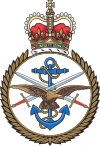Commander-in-chief of the British Armed Forces
| Commander-in-Chief of the British Armed Forces |
|
|---|---|

Tri-service badge
|
|

|
|
| Style | Her Majesty |
| Website | www |
The Commander-in-Chief of the British Armed Forces is a position vested in the British monarch, currently Queen Elizabeth II, who as Sovereign and head of state is the "Head of the Armed Forces". Long-standing constitutional convention, however, has vested de facto executive authority, by the exercise of Royal Prerogative powers, in the Prime Minister and the Secretary of State for Defence, and the Prime Minister (acting with the support of the Cabinet) makes the key decisions on the use of the armed forces. The Queen, however, remains the "ultimate authority" of the military, with officers and personnel swearing allegiance only to the monarch.
The Ministry of Defence is the Government department and highest level of military headquarters charged with formulating and executing defence policy for the Armed Forces; it employed 103,930 civilians in 2006. The department is controlled by the Secretary of State for Defence (or "the Defence Secretary") and contains three deputy appointments: Minister of State for the Armed Forces, Minister for Defence Procurement, and Minister for Veterans' Affairs.
Responsibility for the management of the forces is delegated to a number of committees: the Defence Council, Chiefs of Staff Committee, Defence Management Board, and three single-service boards. The Defence Council, composed of senior representatives of the services and the Ministry of Defence, provides the "formal legal basis for the conduct of defence". The three constituent single-service committees (Admiralty Board, Army Board, and Air Force Board) are chaired by the Secretary of State for Defence.
...
Wikipedia

